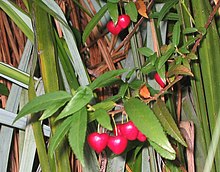Aristotelia peduncularis
| Aristotelia peduncularis | |
|---|---|

| |
| Scientific classification | |
| Kingdom: | Plantae |
| Clade: | Tracheophytes |
| Clade: | Angiosperms |
| Clade: | Eudicots |
| Clade: | Rosids |
| Order: | Oxalidales |
| Family: | Elaeocarpaceae |
| Genus: | Aristotelia |
| Species: | A. peduncularis |
| Binomial name | |
| Aristotelia peduncularis | |
| Synonyms[1] | |
Aristotelia peduncularis, also known as heartberry,[2] is a shrub in the family Elaeocarpaceae, endemic to the wet forests of Tasmania.[1]
Description
Aristotelia peduncularis is a straggly woody monoecious shrub with slender arching branches reaching up to 1.5 metres in height.[3]
Leaves vary in size from 2 to 7 centimetres and are generally ovate to lanceolate with toothed margins, though they may occasionally be deeply lobed.[3] They are held opposite, alternate, or in whorls of three.[4]
Flowers occur in summer and are hermaphroditic, white and campanulate, held singly (or sometimes in a group of 2-3) from long peduncles at axils.[3][5] Each petal is triple-lobed, forming a fringe, and the inside of the flower may have some pink-purple markings.[3]
The fruit is a fleshy, roughly heart-shaped berry, ranging in colour from deep purple-black through to red, pink and white.[2][3]
Distribution
This species is found only, but is widespread, within Tasmania,[6] occurring more commonly in the south.[5] It can be found in relative abundance in the understorey of wet forests where conditions are consistently moist and shady,[2][3] often on mountain slopes and in fern gullies (60-600m)[5]
References
- ^ a b c "Vascular Plants". biodiversity.org.au. Retrieved 2019-12-11.
- ^ a b c "Key to Tasmanian Dicots". www.utas.edu.au. Retrieved 2019-12-11.
- ^ a b c d e f Howells, Christine, ed. (2012). Tasmania's Natural Flora. Hobart, Tasmania: Australian Plants Society Tasmania Inc., Hobart Group. p. 120. ISBN 9780909830663.
- ^ "Species information: Aristotelia peduncularis". www.utas.edu.au. Retrieved 2019-12-11.
- ^ a b c Coode, M. J. E. (1985). "Aristotelia and Vallea, Closely Related in Elaeocarpaceae". Kew Bulletin. 40 (3): 479–507. doi:10.2307/4109610. JSTOR 4109610.
- ^ "Communities". www.understorey-network.org.au. Retrieved 2019-12-11.
